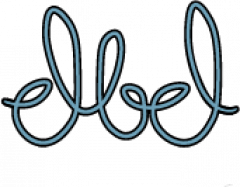I want to sew! Where do I start? Part II, Jargon edition
Read part 1 HERE.
If you have spent some time on the DBD facebook group, you have have stopped more than a few times thinking "WHAT are they talking about?!" Here are some terms and slang that comes up a lot in discussion.
Armscye - The curve where the sleeve attaches.
Applique - An embellishment by layering cut fabric on the foundation fabric and stitching down to secure.
Backstich - To secure a line of stitches, start a little in from where the stitches are to start. Set the machine in reverse for a little bit, and then forward for the rest of the seam. There are other ways, and for handstitcing it looks a little different, but this is one of the most common.
Basting - A long running stitch to temporarily hold fabric together, easy to remove.
Bias - The imaginary diagonal line at a 45 degree angle to the warp and weft of woven fabric.
Casing - The tunnel created by two parallel stitches for elastic or drawstring.
Dart - A seam along a wedge shape designed to shape a garment typically at the bust and waist.
Ease - The difference between the body measurements and the finished garment measurement. A positive ease means that there is more room for movement (or layering), a negative ease means that the pattern is more form fitting. CAN ALSO MEAN: working a slightly larger piece of fabric to match a slightly smaller one without true gathers or pleats. A more advance technique often used, for example, in setting woven sleeves
Embroidery - A decorating technique accomplished by stitching thread, ribbon, or other material on the fabric. Can be done by hand or with a special embroidery machine.
Fat half - This will come up a lot in custom fabric groups. A fat half is the same length as a yard (36") but half the width of fabric (also refered to as WOF), usually around 28-30". Many people try to get a FH of something to have a pattern they like but don't want to spend a lot on.
Grading - Resizing a pattern or blending two different sizes to customize fit.
Grain - The direction of the threads (in woven) or yarn (in knit).
Grainline - The notation on a pattern that shows the correct orientation with regards to the fabric.
Hem - As a verb, to turn up the raw edge and sewing it to create a folded edge. As a noun, it described this type of finish on a garment.
Interfacing - A fabric used in between layers or affixed to the wrong side of the garment's fabric. While it can have many purposes, it is primarily used to stiffen fabric, add body, or adjust the drape of fabric.
Muslin - Either a plain, unbleached cotton fabric, or the first draft of a pattern used to check for fit.
Notions - Any number of accessories used for sewing, including but not limited to: zippers, buttons, seam ripper, snips, hem tape, clips...
Seam allowance - When you put two (or more) pieces of fabric together, there is always a bit of raw edge left outside of the stitches. This is called the seam allowance, sometimes shortened to SA. Patterns will usually include seam allowance (DBD patterns typically have 1/4" seam allowance), but some, especially European patterns, don't. In that case, you will have to use your ruler and draw the seam allowance on the outside of the pattern (more on that later).
Selvege - The small lines of fabric on either end of the fabric's width that runs parallel to the grain.
Serger - Unlike a sewing machine, a serger will have 3-5 spools of thread. Two of them are loopers, and anywhere from 1-3 are needle threads. While the needles stitch, the loopers encase the raw edge. While a serger gives a professional finish and stretch all at once, they tend to be expensive and it's not a necessity. Though, once you have one, you may wonder what you did without it.
Stretch stitch - When sewing knit fabric, a simple straight stitch (usually number 1 on sewing machines) won't stretch with the fabric. A stretch stitch isn't one kid of stitching, but any that allows the thread to stretch along with the fabric. Typically, sewists will use a zig zag stitch or a triple stitch.
Width of fabric - A yard is always 36", a meter is always... well, a meter. The width of fabric (WOF) is the distance from selvege to selvege.
This is just a small sample - the sewing dictionary is, well, the size of a dictionary!
Join us next time when we discuss the anatomy of a sewing machine.
